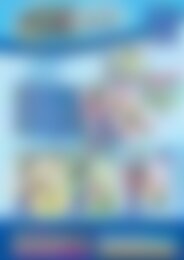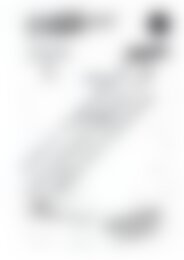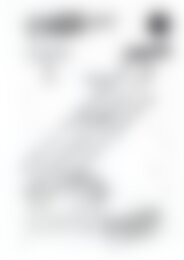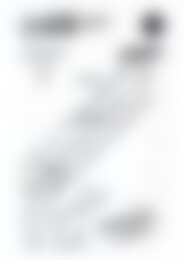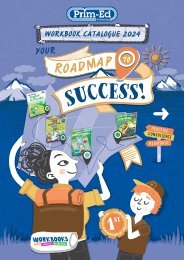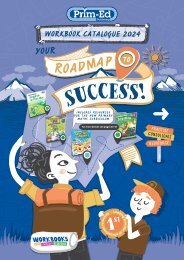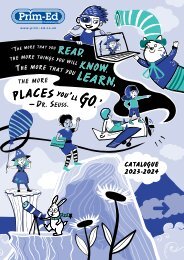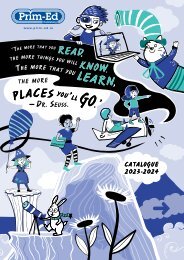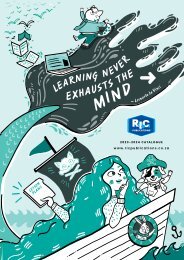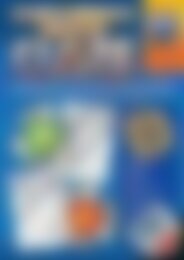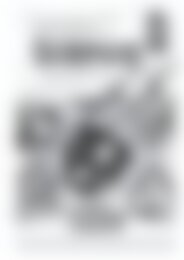RIC-20950 Early years Fantasy - Witches
Create successful ePaper yourself
Turn your PDF publications into a flip-book with our unique Google optimized e-Paper software.
EARLY YEARS THEMES<br />
<strong>Fantasy</strong><br />
<strong>Witches</strong><br />
A complete unit of lessons and activities
<strong>Early</strong> <strong>years</strong> themes—<strong>Fantasy</strong><br />
Published by R.I.C. Publications ® 2011<br />
Copyright © R.I.C. Publications ® 2011<br />
<strong>RIC</strong>– <strong>20950</strong><br />
Titles in this series:<br />
<strong>Early</strong> <strong>years</strong> themes—Places<br />
<strong>Early</strong> <strong>years</strong> themes—People<br />
<strong>Early</strong> <strong>years</strong> themes—Animals<br />
<strong>Early</strong> <strong>years</strong> themes—Science<br />
<strong>Early</strong> <strong>years</strong> themes—<strong>Fantasy</strong><br />
<strong>Early</strong> <strong>years</strong> themes—Fairytales<br />
<strong>Early</strong> <strong>years</strong> themes—Special days and celebrations<br />
Copyright Information<br />
Only the blackline masters contained within this<br />
publication may only be reproduced by the original<br />
purchaser for use with their class(es). The publisher<br />
prohibits the loaning or onselling of these blackline<br />
masters for purposes of reproduction. No other part of<br />
this publication may be reproduced in any form or by any<br />
means, electronic or mechanical, including photocopying<br />
or recording, or by any information storage and retrieval<br />
system, without written permission from the publisher.<br />
Accompanying resources:<br />
<strong>Early</strong> <strong>years</strong> themes—<strong>Fantasy</strong> Posters (set of 5)<br />
<strong>Early</strong> <strong>years</strong> themes—<strong>Fantasy</strong> Stickers (set of 5)<br />
<strong>Early</strong> <strong>years</strong> themes Interactive CD (Places, People,<br />
Animals, Science)<br />
<strong>Early</strong> <strong>years</strong> themes Interactive CD (<strong>Fantasy</strong>, Fairytales,<br />
Special days and celebrations)<br />
Internet websites<br />
In some cases, websites or specific URLs may be recommended. While these are checked and rechecked at the time of publication,<br />
the publisher has no control over any subsequent changes which may be made to webpages. It is strongly recommended that the class<br />
teacher checks all URLs before allowing students to access them.<br />
View all pages online<br />
PO Box 332 Greenwood Western Australia 6924<br />
Website: www.ricpublications.com.au<br />
Email: mail@ricgroup.com.au
<strong>Early</strong> themes – <strong>Fantasy</strong><br />
Foreword<br />
<strong>Early</strong> themes—<strong>Fantasy</strong> is one of a new series of teacher resource books designed to support teachers as they impart knowledge<br />
about commonly-taught themes in early childhood classrooms. The books contain a variety of ideas for using the themes to<br />
assist teachers as they convey early skills and concepts using cross-curricular activities in learning centres or whole-class<br />
activities.<br />
Titles in this series include:<br />
Supporting materials available from R.I.C.<br />
• <strong>Early</strong> themes—Places<br />
Publications ® to accompany these books<br />
• <strong>Early</strong> themes—People<br />
include posters, stickers and interactives.<br />
• <strong>Early</strong> themes—Animals<br />
• <strong>Early</strong> themes—Science<br />
• <strong>Early</strong> themes—<strong>Fantasy</strong><br />
• <strong>Early</strong> themes—Fairytales<br />
• <strong>Early</strong> themes—Special days and celebrations<br />
Contents<br />
Teachers notes ......................................................................... iv – xiii<br />
The format of this series of books .............................................. iv – v<br />
An explanation of the icons ............................................................ vi<br />
About the artwork ......................................................................... vii<br />
About the resource sheets/blacklines ............................................... vii<br />
Curriculum links .......................................................................... viii<br />
Sample social skills checklist ......................................................... ix<br />
Sample language skills checklist ..................................................... x<br />
Sample fi ne motor skills checklist ................................................... xi<br />
Sample fundamental movement skills checklist ................................ xii<br />
Sample mathematics skills checklist .............................................. xiii<br />
Dragons...................................................................................... 1–20<br />
Fairy folk................................................................................... 21–40<br />
Monsters and giants .................................................................. 41–60<br />
Mermaids ................................................................................. 61–80<br />
<strong>Witches</strong> .................................................................................. 81–100<br />
R.I.C. Publications ® – www.ricpublications.com.au <strong>Early</strong> <strong>years</strong> themes—<strong>Fantasy</strong> iii
Teachers notes<br />
The format of this series of books<br />
This series of books is designed to cater for early childhood teachers who use learning centres and cross-curricular activities as<br />
a basis for planning activities to develop key concepts and skills. Teachers will easily be able to locate activity-based learning<br />
within this complete compilation of ideas.<br />
All of the five themes within each book follow the same format over 20 pages. Each theme consists of:<br />
1. A title or cover page with<br />
appropriate artwork which the<br />
teacher can utilise for themebased<br />
activities.<br />
2. A number of pages of cross-curricular learning activities to develop the<br />
theme. Those themes which relate closely to a specifi c learning area may<br />
have more activities in key learning areas such as science. All themes<br />
have activities which are predominantly ‘hands-on’.<br />
Cross-curricular activities<br />
• Make a chart or set of cards of fairy folk-related<br />
words, such as fairy, wand, magic, wings, toadstool.<br />
Draw a picture next to each. Provide magnetic letters<br />
or stamps of each of the letters in the words. The<br />
children can choose a word, make it with the stamp<br />
letters or magnetic letters, then draw a picture of the<br />
word they made. (Language)<br />
English<br />
• Give children laminated pictures of characters from a<br />
fairy-related story they know, and a few props, such<br />
as a magic wand, a pillow, some dress-up wings<br />
or a bag of ‘fairy dust’ (glitter). The children work<br />
in pairs or small groups with an adult to create and<br />
share a new story using the characters and props<br />
they have. (Literacy)<br />
• Add fairy stamps, glitter and clear or sparkling cellophane to the writing<br />
centre. Add glitter to playdough, with which the children can make the letter<br />
‘f’ or spell out ‘fairy’ (or other theme-related letters or words). The children<br />
can write or trace other focus letters with glitter glue pens. (Language) • Print or photocopy some pictures<br />
of fairies and other fairy folk. Glue<br />
• The children can draw or paint an imaginary fairy creature, or make one them onto card and laminate. Hide<br />
from playdough. They then give their creature a name and write as much the fairy folk pictures around the<br />
of that name as they can. Collect the images (or take photos of playdough classroom. Children go on a hunt<br />
creations) and compile then as a class book, or use these characters to to fi nd them and when they do,<br />
create your own class fairytales. (Literacy)<br />
they describe the creature using<br />
as many descriptive words as they<br />
can. (Literacy)<br />
• After reading stories involving different types of fairy folk, • Read a story such as the Brothers Grimm’s ‘The elves and<br />
talk about some of the characteristics of the folk. Ask the the shoemaker’. Give each child a large piece of paper<br />
children to give some descriptions of the typical traits of folded into thirds. The children draw the beginning, middle<br />
folk; for example: fairies are often mischievous, gnomes and end of the story, then retell it in their own words using<br />
are often grumpy. Ask the children to select one type their pictures as cues. (Language)<br />
of fairy folk or a character from a story they associate<br />
• The children can draw or ‘write’ a letter to the tooth fairy<br />
with or feel they are like in some way. They draw this<br />
(after reading a storybook such as Dear Tooth Fairy by<br />
character and tell an adult (who scribes) why they<br />
Alan Durant) on tooth- or fairy-shaped paper. (Language)<br />
feel they are like this character; for example, ‘I am like<br />
Bashful, the dwarf, because I am a bit shy sometimes’. • Introduce the letter ‘f’ with a fl ower fairy (a fairy fl ying over<br />
(Literature)<br />
a fl ower drawn in an ‘f’ shape). (Language)<br />
• Make pairs of cards with pictures and names of characters from a story the children know. Place these face down in a<br />
grid. The children turn over two cards and try to link the two characters in some way. For example, if the class is studying<br />
Sleeping beauty and a child turns over images of Malefi cent and the Prince, the child could say, ‘Malefi cent tried to kill the<br />
Prince’. If a child connects the two characters, he/she keeps the cards, if not the cards must be returned. (Literacy)<br />
• Do some ‘magic writing’. The children write • With the children, plan a fairy party with fairy bread, fairy<br />
target letters (such as ‘f’ for fairy or copy whole cupcakes (see recipes page 37) and games (page 26).<br />
words) in white crayon. They then go over the The children can make invitations to parents or others in the<br />
writing with a tempera paint wash and the writing centre. Once written, add glitter, roll into a scroll and<br />
letters will magically appear. (Language)<br />
tie with coloured ribbon. (Language)<br />
• Listen to stories about fairy folk. Make up a sound for each of the main characters, such as ‘La, la, la!’ for the fairy, ‘Grumble,<br />
grumble!’ for the troll or ‘Stomp, stomp!’ for the giant. Each time the character is mentioned, the children make the sound that<br />
goes with him/her. (Literacy)<br />
22 <strong>Early</strong> <strong>years</strong> themes—<strong>Fantasy</strong>—Fairy folk www.ricpublications.com.au – R.I.C. Publications ®<br />
3. Background information with useful<br />
facts about the theme.<br />
4. A list of concepts to be developed<br />
provides suggested developmentallyappropriate<br />
learning outcomes that<br />
are achieved by completing the<br />
theme.<br />
iv <strong>Early</strong> <strong>years</strong> themes—<strong>Fantasy</strong> www.ricpublications.com.au – R.I.C. Publications ®
Teachers notes<br />
The format of this series of books<br />
5. A small number of resource/blackline pages which can be used<br />
to create games or oral language activities, as templates for art<br />
and craft activities or as worksheets for more capable children who<br />
are beginning to read and understand mathematical concepts.<br />
6. Recipes relating to the theme—simple<br />
cooking and non-cooking recipes,<br />
including those for manipulative play,<br />
such as ‘goop’.<br />
Recipes<br />
Cute cupcakes witches<br />
Ingredients<br />
• 1 packet cupcake mix<br />
• green food colouring<br />
• vanilla frosting<br />
• 2 tsp. milk<br />
• assorted food colouring of your choice<br />
• 12 to 16 small ice-cream cones<br />
• Fruit Roll-ups , licorice and assorted candies of your choice<br />
Instructions<br />
• Make cupcakes and allow to cool. Tint half of frosting green and use on cupcakes. Combine remaining frosting and milk, add<br />
choice of food colouring and coat ice-cream cones. Decorate cone hats with cut out shapes from Fruit Roll-ups . Add licorice<br />
for hair and candies for faces of the cupcakes. Place a cone hat on each cupcake witch.<br />
Ice-cream witches<br />
Ingredients<br />
• lime ice-cream (or vanilla ice-cream tinted with green food colouring)<br />
• black licorice strips, red and orange round candy<br />
• apple segment<br />
• ice-cream cones<br />
Instructions<br />
• Place scoops of lime ice-cream on a sheet of baking paper. Decorate quickly using black licorice strips for the hair, round red<br />
or orange lollies for the eyes and an apple segment for the nose. Add a small ice-cream cone for the hat. Place in freezer for<br />
15 minutes, then serve.<br />
Spider cake<br />
Ingredients<br />
• 2 round (15-cm wide) white sponge cakes<br />
• green jelly<br />
• chocolate icing<br />
• blue food colouring<br />
• 2 large round pieces of candy for eyes<br />
• 4 fl at long licorice strips<br />
Instructions<br />
• Make green jelly and place in fridge to set. Place one cake on<br />
a platter and cut a circle out of the centre for the spider’s head.<br />
Fill hole in cake with set jelly. Place other cake on top. Place the<br />
spider’s head in place on the platter. Prepare chocolate icing,<br />
then add blue food colouring until it looks blackish. Cover spider<br />
with icing. Cut licorice in half and attach to cake to make 8 legs.<br />
Add eyes and place cake in fridge until ready to serve.<br />
Note: The spider should ooze green slime when cut.<br />
96 <strong>Early</strong> <strong>years</strong> themes—<strong>Fantasy</strong>—<strong>Witches</strong> www.ricpublications.com.au – R.I.C. Publications ®<br />
7. Display ideas for art and craft or<br />
specifi c learning centres.<br />
8. A list of literature resources to<br />
complement the theme, including<br />
songs, action rhymes and fi ction<br />
and nonfi ction books.<br />
9. A notes section to enable the teacher<br />
to record useful websites or resources<br />
relating to the theme, or other<br />
worthwhile activities or ideas etc.<br />
R.I.C. Publications ® – www.ricpublications.com.au <strong>Early</strong> <strong>years</strong> themes—<strong>Fantasy</strong> v
Teachers notes<br />
An explanation of the icons<br />
A number of icons have been used throughout the cross-curricular activities sections to make it easier and quicker for teachers to<br />
locate appropriate learning activities.<br />
Fine motor activities—building with blocks, puzzles, sorting, sand and water play, sensory items<br />
such as ‘feely boxes’, playdough or clay work, threading, chalkboards, construction using recycled<br />
materials such as boxes<br />
Outdoor play—sand and/or water play (see also ‘fi ne motor activities’); gross motor activities such as<br />
climbing, balancing, bikes, scooters, jumping, throwing, obstacle course activities etc.; tracking activities<br />
using balloons and bubbles etc.; other messy art activities<br />
Dramatic play—home corner, dramatising stories, dressing up, puppets, shopping etc.<br />
Art and craft—free painting, directed and supervised painting,<br />
craft (assisted and independent)<br />
Computer—suggestions for simple games or activities (usually<br />
individual or in pairs) or relevant internet activities<br />
Cooking—supervised activities, some of which use heat<br />
Games—indoor or outdoor games relating to literacy such as card games, memory<br />
games etc.; mathematics, singing games, any physical education games involving<br />
movement etc.<br />
Writing—tracing, copying, writing on, and with, different things—cards, different types of paper etc.;<br />
adding patterns or stripes etc.; tracking and following paths, dot-to-dot activities etc.<br />
vi <strong>Early</strong> <strong>years</strong> themes—<strong>Fantasy</strong> www.ricpublications.com.au – R.I.C. Publications ®
Teachers notes<br />
About the artwork<br />
All the artwork in this series of books is:<br />
• age-appropriate<br />
• teacher- and child-friendly<br />
• an additional resource to help develop the theme<br />
• suitable for enlarging for:<br />
~ colouring<br />
~ handwriting<br />
~ dot-to-dot sheets<br />
~ use as templates for art and craft activities<br />
~ visual texts to encourage oral language development.<br />
Some artworks are based on simple shapes to support learning in the mathematics area; others are more elaborate. It is<br />
anticipated that early childhood teachers will view an illustration based on shapes and be able to use this idea to develop<br />
concrete play activities using shapes or as a technology and design project. More elaborate artwork is used to demonstrate a<br />
teaching resource which needs to be made, a recipe, game or other activity.<br />
Examples of artwork relating to art and craft activities have wide, bold, easily visible cutting outlines to allow the children some<br />
variation in the cutting path they will use.<br />
About the resource sheets/blacklines<br />
All resource sheets/blacklines contain:<br />
• simple, age-appropriate artwork<br />
• prominent visual clues<br />
• little or no text<br />
• visual clues to support text pages<br />
• few instructions, so as not to confuse beginning readers<br />
• teacher instructions in the margins with a number of<br />
different suggestions for using the resource sheet/blackline<br />
• literacy and numeracy activities.<br />
These resource sheets/blacklines are included as valuable<br />
time-savers for teachers.<br />
It is anticipated that the teacher will enlarge any pages to A3<br />
size and photocopy them onto more durable paper or card, to<br />
make them easier for learners of this age group to manipulate.<br />
The cross-curricular section of each theme includes a reference<br />
to resource sheets/blacklines relating to specifi c activities.<br />
R.I.C. Publications ® – www.ricpublications.com.au <strong>Early</strong> <strong>years</strong> themes—<strong>Fantasy</strong> vii
Teachers notes<br />
Curriculum links<br />
All the learning activities in this series of books support the key learning areas of the current curriculum documents.<br />
In particular, one or more activities also support each strand of the new English and Mathematics National Curriculum. The<br />
specifi c strands from the National Curriculum relating to each activity are denoted by the words in brackets in the English and<br />
Mathematics learning areas of the cross-curricular section.<br />
For example, in the ‘Dragons’ theme:<br />
English Identify the initial letter ‘d’ for ‘dragon’. Brainstorm, record and display words which begin with ‘d’. Use<br />
the dragon outline on page 10 to display your ‘d’ words. (Language)<br />
Mathematics Use arbitrary units to calculate the area of various dragon footprints. (Measurement and Geometry)<br />
Reference to both is shown below.<br />
Relevant curriculum reference<br />
NSW<br />
Qld<br />
SA<br />
Vic.<br />
WA<br />
National Curriculum: refer to pages 6 and 11 of Shape of the Australian Curriculum: English<br />
National Curriculum: refer to pages 6 and 7 of Shape of the Australian Curriculum: Mathematics<br />
National Curriculum: Science learning activities also support pages 6 and 7 Shape of the Australian<br />
Curriculum: Science<br />
Belonging, being and becoming: The early <strong>years</strong> framework for Australia (2009)<br />
Refer to <strong>Early</strong> <strong>years</strong> curriculum guidelines page 55 (Table 9: A<br />
summary of the learning statements in the early learning areas)<br />
and pages 61–75.<br />
Refer to ‘<strong>Early</strong> <strong>years</strong> band: Age 3–Age 5’. South Australian<br />
Curriculum, Standards and Accountability at .<br />
Refer to Victorian Essential Learning Standards Level 1 at<br />
.<br />
Refer to K-3 scope-and-sequence charts at .<br />
viii <strong>Early</strong> <strong>years</strong> themes—<strong>Fantasy</strong> www.ricpublications.com.au – R.I.C. Publications ®
Teachers notes<br />
Sample social skills checklist<br />
Date:<br />
Student name<br />
separates easily<br />
from parents<br />
interacts readily with<br />
adults<br />
interacts readily with<br />
peers<br />
shares with others<br />
and takes turns<br />
participates in group<br />
activities<br />
cooperates with<br />
others<br />
accepts<br />
responsibility for<br />
own behaviour<br />
respects the property<br />
of others<br />
respects the feelings<br />
of others<br />
listens without<br />
interrupting<br />
expresses feelings<br />
appropriately<br />
solves simple<br />
problems<br />
is developing an<br />
awareness of the<br />
wider community<br />
R.I.C. Publications ® – www.ricpublications.com.au <strong>Early</strong> <strong>years</strong> themes—<strong>Fantasy</strong> ix
Teachers notes<br />
Sample language skills checklist<br />
Date:<br />
Student name<br />
communicates needs clearly<br />
articulates most words correctly<br />
relates personal experiences<br />
contributes to discussions<br />
uses age-appropriate<br />
vocabulary<br />
articulates most initial sounds<br />
correctly<br />
asks appropriate questions<br />
speaks in complete sentences<br />
relates events in order of<br />
occurrence<br />
able to tell a story from pictures<br />
retells a familiar story without<br />
pictures or clues<br />
uses simple compound<br />
sentences<br />
responds appropriately to<br />
questions about himself/herself<br />
listens to a story for a given<br />
length of time<br />
follows simple two-step<br />
instructions<br />
knows his/her fi rst and last<br />
name<br />
recognises rhyming words<br />
answers simple oral cloze<br />
questions<br />
labels emotions such as happy,<br />
sad, angry, scared …<br />
x <strong>Early</strong> <strong>years</strong> themes—<strong>Fantasy</strong> www.ricpublications.com.au – R.I.C. Publications ®
Teachers notes<br />
Sample fine motor skills checklist<br />
Date:<br />
Student name<br />
completes simple puzzles<br />
builds a tower of eight or more<br />
small blocks<br />
dresses himself/herself (apart<br />
from buttons and shoelaces)<br />
manipulates playdough to<br />
create a specifi c object<br />
places small pegs in small<br />
holes<br />
threads small beads<br />
uses scissors to cut out simple<br />
shapes and pictures<br />
completes simple folding<br />
activities<br />
uses a knife, fork and spoon<br />
correctly<br />
holds a crayon or pencil<br />
correctly<br />
colours within lines<br />
writes or copies own name<br />
draws and copies simple<br />
pictures<br />
copies a sequence of letters or<br />
numbers adequately<br />
traces or recreates patterns<br />
R.I.C. Publications ® – www.ricpublications.com.au <strong>Early</strong> <strong>years</strong> themes—<strong>Fantasy</strong> xi
Teachers notes<br />
Sample fundamental movement skills checklist<br />
Date:<br />
Explicit teaching<br />
Exposure<br />
Student name<br />
balances on one<br />
foot (static balance)<br />
runs<br />
jumps vertically<br />
catches a ball or<br />
beanbag<br />
hops<br />
throws a ball or<br />
beanbag using an<br />
overarm movement<br />
gallops sideways<br />
skips<br />
leaps<br />
kicks a ball<br />
strikes a ball or<br />
object using a twohanded<br />
strike<br />
dodges a ball or<br />
object<br />
xii <strong>Early</strong> <strong>years</strong> themes—<strong>Fantasy</strong> www.ricpublications.com.au – R.I.C. Publications ®
Teachers notes<br />
Sample mathematics skills checklist<br />
Date:<br />
Number and algebra Measurement and geometry Statistics and probability<br />
Student name<br />
recognises numerals 1 to<br />
writes numerals 1 to<br />
rote counts to<br />
places numerals to<br />
in correct order<br />
understands one-to-one<br />
correspondence<br />
understands ‘more than’ or ‘less<br />
than’<br />
able to do simple addition and<br />
subtraction using concrete materials<br />
shares collections<br />
creates or completes a pattern<br />
measures using everyday items<br />
makes comparison of size and<br />
length<br />
recognises basic shapes<br />
identifi es attributes of objects and<br />
collections<br />
is aware of devices used for<br />
measuring (scales, tapes etc.)<br />
shows awareness of<br />
(money, temperature, time etc.)<br />
sorts or orders objects<br />
is aware of collections and<br />
presentations of data<br />
interprets data in a display<br />
makes predictions about chance<br />
events<br />
R.I.C. Publications ® – www.ricpublications.com.au <strong>Early</strong> <strong>years</strong> themes—<strong>Fantasy</strong> xiii
Cross-curricular activities<br />
English<br />
• Explore reasons why bats are associated with witches, such as their dark colour, where they live, when they fl y and that they<br />
are often one of the ingredients in witches’ spells. (Literacy)<br />
• Make up a list of ingredients (with specifi c quantities) for a witch’s potion; e.g. 5 frog legs, 2 lizards. Write each ingredient<br />
on a card and attach the cards to a large cauldron drawn on a large sheet of paper and displayed on the wall. Encourage the<br />
children to collect pictures or make drawings of the ingredients to add to the cauldron. They can practise reading the displayed<br />
recipe. (Literacy)<br />
• Read Bony legs by Joanna Cole. Encourage the children to talk about the witch, why she was wicked and how the little girl<br />
was able to trick her and escape. (Literature)<br />
• Compile a Y-chart, recording children’s ideas about what a witch looks like (e.g. black, ugly); sounds<br />
like (e.g. screeching, cackling) and feels like (e.g. scary, wicked). Children can ‘read’ the words from<br />
the chart. (Literacy)<br />
• Read the story of ‘Hansel and Gretel’. Talk about how the witch tried to trick the children. Possible<br />
reasons include: by living in a house made of sweets so children would like it and want to stay;<br />
pretending to be kind; giving Hansel lots of food to eat. Then discuss how the children tricked the witch;<br />
for example: poking a bone out of the cage and persuading the witch to put her head in the oven.<br />
(Literature)<br />
• Collect pictures of black things and glue them on a wall chart divided into two sections: ‘Black things<br />
we like’ and ‘Black things we don’t like’. Label each picture and encourage children to read the labels.<br />
Each child can have a turn to choose and talk about one of the pictures and to explain why he or she<br />
likes or dislikes that particular black thing. They could also try to speculate whether a witch would agree with them.(Literacy)<br />
• Read the story ‘Rapunzel’ and talk about the good and bad<br />
things the witch did; for example: she looked after Rapunzel<br />
well, was kind to her and visited her every day; but she<br />
locked her away in the tower, cut off her hair, tricked the<br />
prince into climbing up the cut-off hair, made the prince so<br />
sad that he jumped off the tower and became blind and sent<br />
Rapunzel to live by herself in the desert. (Literature)<br />
• Retell the story of Rapunzel, using a series of pictures as<br />
prompts. Then give a group of children sitting in a line a<br />
picture each and ask the fi rst of them to retell his or her<br />
part of the story. After the child has fi nished, encourage the<br />
listeners to add any details the reteller has missed, then<br />
proceed to the next child and picture and repeat the process.<br />
The children can then take turns at retelling the part of the<br />
story related to each picture. (Literature)<br />
• Draw a large picture of a witch and display it on a board.<br />
Give the children cards with words to be placed near each<br />
appropriate part of the witch. Examples include: hat, nose,<br />
mouth, eyes, head, hands, feet, broomstick, shoes, cloak<br />
and raven. Children can practise reading the cards. (Literacy)<br />
• Read Winnie the witch by Valerie Thomas and Korky Paul.<br />
As a class, think of other names beginning with ‘W’ to call a<br />
witch. Clap the syllables in each name. (Literature)<br />
• Turn the book corner into a bat cave, using large<br />
cardboard boxes painted black or with tables and<br />
blankets. Some bats, cobwebs and spiders could be<br />
added. Use the cave to read books about bats. The cave<br />
could also be used for dramatic play. (Literature)<br />
• Provide laminated cards for children to use in the writing<br />
corner. Write a word related to witches (adjectives and<br />
nouns) on each card. Place pictures of each word in<br />
a box and encourage children to match them to the<br />
words. (Language)<br />
82 <strong>Early</strong> <strong>years</strong> themes—<strong>Fantasy</strong>—<strong>Witches</strong> www.ricpublications.com.au – R.I.C. Publications ®
<strong>Witches</strong> – 1<br />
Mathematics<br />
• Ask children to pretend that one of them is a witch or wizard who wants to cast a spell on the principal but doesn’t know<br />
where the principal’s offi ce is and how to get there. The other children all want to help turn the principal into a frog, so they<br />
have to tell the witch how to reach the offi ce. (Measurement and Geometry)<br />
• Put about 10 cm of water in a large pot and colour it black by adding a small amount of tempera paint. Add about 10<br />
‘witches’ worms’; these can be polystyrene s-shaped packing pieces or coloured jelly snakes. Children take turns to grab<br />
some ‘worms’, which they then count before replacing them in the pot. (Number and Algebra)<br />
• Discuss unpleasant animals and make a list of<br />
those the children don’t like, including some of the<br />
creatures associated with witches. Encourage the<br />
children to talk about these animals. Ask them to<br />
think about which creature they think is the worst.<br />
The children can then vote to fi nd the animal the<br />
class most dislikes. Tally the votes and record the<br />
scores. Use this information to make a pictograph<br />
or a simple bar graph. (Statistics and Probability)<br />
• Teach a rhyme such<br />
as ‘Five small bats’<br />
to help the children<br />
count backwards from<br />
fi ve to zero. (Refer to<br />
page 99.) (Number<br />
and Algebra)<br />
• Make sets of eight spider cards, giving each spider a different number of legs. Children then arrange the spider cards in<br />
order according to the number of legs they have. (Number and Algebra)<br />
• Make patterns for children to complete using witch-themed stickers; for example: 1 witch, 3 black cats, 1 witch, 3 black<br />
cats ... (Number and Algebra)<br />
• Draw the outline of a large witch with clearly defi ned features and attach it to the fl oor. Give the children blocks or short<br />
lengths of wood and ask them to measure how many blocks long her head, legs, arms, hands etc. are. (Measurement<br />
and Geometry)<br />
• Children sort a collection of pictures of witch-related animals into; for example, toads and cats, and then sort them again<br />
according to colour. Then they describe the groups they have made; for example: ‘I have 3 blue cats, 1 yellow cat, 2<br />
green toads and 2 black toads.’ (Number and Algebra)<br />
• Cut lolly snakes of different colours and lengths in half and mix them up. (Note: To ensure you start with snakes of<br />
different lengths, you will need to make some shorter by cutting a piece off before halving them.) Children will need to<br />
understand that halves are of equal size in order to match the snake parts correctly. (Measurement and Geometry)<br />
• Teach the comparatives: bigger, biggest; smaller, smallest; taller, tallest; and shorter, shortest using three different-sized<br />
pictures of witches and associated creatures. Children can demonstrate their understanding of the concept by selecting<br />
the appropriate pictures. They could then complete a simple worksheet by circling or colouring the relevant drawings.<br />
(Measurement and Geometry)<br />
R.I.C. Publications ® – www.ricpublications.com.au <strong>Early</strong> <strong>years</strong> themes—<strong>Fantasy</strong>—<strong>Witches</strong> 83
Cross-curricular activities<br />
Science<br />
• Place some real spiders in a glass jar for the children to observe. They could, for example, count their legs, determine their<br />
body parts and describe their behaviour. Explain that the spiders will need to be returned to their natural environment later in<br />
the day.<br />
• Make ‘magic milk’. Pour some milk on a shallow plate and add a few drops of food colouring. A few drops of liquid soap is<br />
then added to magically change the milk.<br />
• Discuss bats with children to determine their understanding. Many children<br />
will be unfamiliar with these animals and may even be confused about<br />
whether they are real or imaginary. They will benefi t from opportunities to<br />
engage with some well-illustrated informational texts. Encourage them to<br />
provide facts about real bats, such as they are not blind; they hang upside<br />
down; eat fruits, fl owers, leaves, insects, frogs, fi sh and small mammals and<br />
reptiles; and their young are called ‘pups’.<br />
• Introduce this activity by talking about cats and ravens and how witches<br />
often use both of them as helpers to, for example, collect ingredients for their<br />
potions and to collect information by acting as their spies. Compare these<br />
two animals by discussing obvious similarities and differences, recording this<br />
information on a chart using words and illustrations. A poster-sized picture of<br />
each may help children to generate ideas.<br />
• Talk about the life cycle<br />
of frogs and toads and<br />
collect or draw pictures<br />
to make a chart showing<br />
an adult, eggs, young<br />
tadpoles without legs and<br />
with long tails, and mature<br />
tadpoles with short tails<br />
and developing legs.<br />
• Make a bubbling witch’s brew. Fill a small<br />
witch’s ‘cauldron’ with two tablespoons<br />
of water and a few drops of blue food<br />
colouring. Add one tablespoon of baking<br />
soda and stir until it dissolves. Pour two<br />
tablespoons of vinegar into a separate<br />
cup and add a few drops of yellow food<br />
colouring. Pour all the vinegar into the<br />
cauldron and watch it change colour and<br />
bubble up. Note: The ‘cauldron’ should be<br />
placed on a tray to catch the overfl ow.<br />
Society and environment<br />
• Find some illustrations of witches’ homes and look at and talk about<br />
some of their features; for example: the location—perhaps on a cliff<br />
or in a deserted, lonely place; the colour:—often black and gloomy;<br />
surroundings—perhaps stark trees, cobwebs and scary black creatures.<br />
Encourage children to talk about their own homes and how they differ<br />
from witches’ homes.<br />
• Discuss friends and friendship, encouraging children to talk about their<br />
friends and some of the things they do together. Pose the questions:<br />
– Do witches have friends?<br />
– Do they do the things you do with your friends?<br />
– Would you like to have a witch as your friend?<br />
Encourage the children to discuss and explain their answers.<br />
• Brainstorm and make a list of different forms of transport children use or know about. They can look through magazines<br />
to fi nd pictures of each type to glue on a chart. Discuss each form and ask how a witch gets from one place to another.<br />
Encourage the children to speculate about whether a witch would use any of these and to explain why or why not.<br />
Possible reasons could include: people wouldn’t want to sit next to a witch, they would be worried she’d turn them into<br />
something, and that she would think it was too slow or too boring.<br />
84 <strong>Early</strong> <strong>years</strong> themes—<strong>Fantasy</strong>—<strong>Witches</strong> www.ricpublications.com.au – R.I.C. Publications ®
<strong>Witches</strong> – 2<br />
Visual arts<br />
• Make black bats by cutting out a line of three egg carton cups. Turn the<br />
two end cups into wings by cutting away part of the front and back to form<br />
scallop shapes. Paint black and allow to dry before gluing some eyes on<br />
the middle cup. Make two small holes on the top of this section. Thread<br />
black wool or elastic through the holes and hang up.<br />
• Weave a web by fi rst punching 20 holes around a paper plate, all about two centimetres from the edge. Weave a random<br />
pattern from one hole to another, using dark-coloured wool or string. Use adhesive tape to attach the beginning and end to the<br />
back of the plate. Add some ‘fl ies’ by twisting small rectangles of black crepe paper and placing them in the web.<br />
• Create a polystyrene cup spider. Turn the cup upside down. Use eight<br />
pipe-cleaners to make the spider’s legs by pushing them through the<br />
open end of the cup about one centimetre from the edge. Ensure<br />
the legs are not too close together or the cup may crack and come<br />
apart. Glue big eyes on the cup and use a black marker pen to draw<br />
the spider’s mouth.<br />
• Make a paper plate witch. Cut out a simple witch’s hat outline from black paper. Make the witch’s face by painting a paper plate<br />
green and allowing it to dry. Trace around the children’s hands on orange construction paper to make the witch’s hair. When cut<br />
out, glue the hands (orange hair) to the green plate, then add the black hat. Use marker pens or shapes cut from black paper<br />
to add the witch’s eyes, nose and mouth.<br />
• Staple a small paper plate (the spider’s head) securely to a larger one (the spider’s body). Paint<br />
the plates black on both sides. Make spider’s eyes from white paper and glue them on. Add<br />
black streamers for legs. Add a piece of string and suspend the spiders from a longer<br />
length of string stretched across the room.<br />
• Use large triangular shapes cut from pieces of black fabric as wizards’ hats. Glue the<br />
‘hats’ to a sheet of coloured paper. Ask the children to glue smaller shapes cut from<br />
brightly coloured fabric, glitter and other collage materials to decorate their hats.<br />
• Make witches’ hands. Trace around the children’s hands on green card or paper<br />
and cut them out. Make pointed ovals from coloured card or paper to use as long<br />
fi ngernails and glue them on. Stickers or glitter can be added to the nails for greater<br />
effect. Marks such as warts and veins can be drawn on the hands to make them even<br />
more unattractive.<br />
• Make a witch’s broom, using a strong<br />
straight stick about 1.5 metres long. Find<br />
some thin twigs all about 50 cm long.<br />
Tie strong string to the stick about 20 cm<br />
from the end and wrap it around the fi rst<br />
layer of twigs and tie them tightly to the<br />
stick. Add layers of twigs until the broom<br />
is quite thick. Make a band of string about<br />
6 cm wide around the outside of the twigs<br />
to hold them all in place. Children can<br />
talk about how witches use their brooms.<br />
They can then use their own brooms to<br />
sweep up leaves or to play the singing<br />
game ‘Old mother witch’. Refer to .<br />
• Use a large black rubbish bin liner to create a wizard<br />
cape. Cut about 2 cm along the edge of the closed end<br />
of the bag. This can be used later as the tie around the<br />
top of the cape (instead of ribbon). Cut the bag down<br />
one seam and unfold it to make a large rectangle shape.<br />
Fold and tape down a 10-cm seam across the top edge<br />
of the cape. Make slits along this seam and thread<br />
ribbon or the cut-off strip of plastic through the slits to tie<br />
the cape around the wizard’s neck. Turn the cape to the<br />
other side and use clear tape to attach glittery moon and<br />
star shapes to decorate the outside of the cape. Use for<br />
dramatic play.<br />
• Make cat puppets by painting a paper bag black. Glue on<br />
collage materials for eyes, nose, mouth and whiskers.<br />
Twist the corners of the bag carefully to make the cat’s<br />
ears. The children can take turns to interview puppets to<br />
ask questions such as how the cat helps its witch and<br />
why they are always black.<br />
R.I.C. Publications ® – www.ricpublications.com.au <strong>Early</strong> <strong>years</strong> themes—<strong>Fantasy</strong>—<strong>Witches</strong> 85
Cross-curricular activities<br />
Health and physical education<br />
• Play ‘What’s for dinner, Mrs Witch?’ This game is played like the traditional ‘What’s the time, Mr Wolf?’ Mrs Witch (or Mr<br />
Wizard) hides her/his eyes and the other children line up behind and chant, ‘What’s for dinner, Mrs Witch/Mr Wizard?’<br />
The answer could be, for example, fi ve worms, one toad, three spiders or two rats, and they move forward that many<br />
steps. When they hear the answer ‘You’, they all turn and run. Mrs Witch/Mr Wizard turns and chases them and the fi rst<br />
one she/he catches becomes the next Mrs Witch/Mr Wizard.<br />
• Play ‘Don’t stop on my hat’. Draw a large outline of a witch’s hat, colour it black, cut it out and place it fl at on the ground.<br />
The children line up and walk over the hat and back around in a circle. Play music and when it stops, the child standing<br />
on the hat or the last one to cross it, is out of the game. The last child standing is the winner.<br />
• Go on a witch hunt. Provide a ‘witch’, which could be a witch toy, an illustration of a witch or even an adult dressed<br />
as a witch. Set a trail for the children to follow to fi nd the witch. Then complete individual cards, each with a list of very<br />
simple written instructions with pictorial clues, and then hide them in various places. Each card leads the children to the<br />
location of the next card, until fi nally the witch is found. The witch hunters can take turns trying to read the cards.<br />
• Make a list of the horrible things a witch might put into her cauldron to cook. Discuss whether any of the ingredients she<br />
might use would be healthy. Explain that the things a witch could cook in her cauldron would be likely to make you very<br />
sick or change you into some other creature. Then ask the children to suggest some healthy food for the witch to cook.<br />
This food could be written in a list, with matching pictures cut from magazines added.<br />
• Talk to children about how different people and animals move. Encourage them to stride along like a witch or to ride on<br />
a pretend broomstick. They could then jump like a toad, fl y like a raven or a bat, creep like a cat, or scurry like a mouse<br />
or rat.<br />
• Children sit in a circle and one child, the witch, walks<br />
around the outside of the circle carrying a black spider.<br />
One vacant spot is left in the circle. The other children<br />
chant ‘Spider, spider, where are you? Black and hairy<br />
from the witch’s brew. Spider, spider, when you drop,<br />
I’ll start running to fi nd my spot’. The spider is dropped<br />
behind one child, who has to pick it up and race the<br />
witch to the vacant spot in the circle. If that child<br />
reaches the spot before the witch, he or she<br />
is safe and the witch has another turn. If<br />
the witch beats the child with the spider,<br />
that child must walk around and drop<br />
the spider behind another child and the<br />
game continues.<br />
• Play ‘Wicked Witch says’, a game based on the old,<br />
well-known game of ‘Simon says’. This game focuses<br />
on listening skills. In this game, the children can only<br />
do what Wicked Witch says. For example, if Wicked<br />
Witch says ‘stand up’, the children have to follow the<br />
command. But if an order is given such as ‘Put your<br />
hands on your head’, the children can not do it and<br />
are out of the game if they do. The aim is to trick the<br />
children into doing something not prefi xed with<br />
‘Wicked Witch says … ’ or into not following<br />
a Wicked Witch instruction. The last child<br />
left in the game is the winner.<br />
86 <strong>Early</strong> <strong>years</strong> themes—<strong>Fantasy</strong>—<strong>Witches</strong> www.ricpublications.com.au – R.I.C. Publications ®
<strong>Witches</strong> – 3<br />
Drama<br />
• Children role-play being a witch. Provide props such as a container to use as a cauldron, something to stir with, broomsticks,<br />
bats, ravens, toads, witches’ or wizards hats, black cloaks and toy black cats.<br />
• Dramatise the scene from Sleeping Beauty in which the witch, who is sitting in an isolated room of the palace spinning yarn,<br />
is discovered by Sleeping Beauty as she wanders around the palace. Beauty asks her if she can try using the spinning wheel,<br />
but she pricks her fi nger and falls asleep. Ask the children to consider how the witch felt when this happened and what she<br />
may have said and done. Repeat with other familiar stories involving witches.<br />
• Role-play being a witch fl ying on her broomstick, describing all the things she can see from up in the sky. Children could chant<br />
‘Witch, witch, what do you see?’ and the witch could reply ‘I see a (name of an object) looking at me’.<br />
• Children take turns to role-play different creatures associated with witches, such as cats, ravens, toads and bats. The others<br />
have to decide which creatures they are representing by watching how they move and what they do.<br />
• Follow instructions to make a spell. Use a circular mat to represent the witch’s cauldron. The teacher reads from a recipe<br />
and adds the different ingredients by counting and selecting the appropriate number of children. For example, the recipe may<br />
require fi ve toads and three snakes. The children selected to be the ‘ingredients’ then have to role-play their particular creatures<br />
while they stand or sit on the mat.<br />
• Who has the witch’s cat? Children sit in a circle. One child, who is chosen to be the witch,<br />
is blindfolded and sits in the middle of the circle. A toy black cat is passed around the circle<br />
until the witch calls out ‘stop’. The child with the cat and all the other children put their hands<br />
behind their backs and pretend to be hiding the cat. The blindfold is removed and the witch<br />
has to fi nd the cat by asking the question ‘Do you have my cat?’ and guessing from the<br />
responses. When the cat is fi nally located, the child hiding the cat becomes the next witch.<br />
Technology (and design)<br />
• Discuss with the children the advantages and disadvantages of<br />
fl ying on a broomstick rather than in an aircraft. Talk about things<br />
such as fuel, cost, pollution, protection from weather, noise,<br />
speed, passengers and comfort. Work with the children to plan<br />
the features of the world’s best broomstick.<br />
• Design a candy house similar to the one owned by the witch in<br />
Hanzel and Gretel. It should be a very pretty house and it should<br />
taste delicious so children who go there will want to stay. Talk<br />
about suitable confectionary to use for the different parts of the<br />
house, such as the walls, the roof and the doors. Children may<br />
like to make their choices based, for example, on colours, size<br />
or taste. They may also like to consider planning the garden.<br />
• Visit .<br />
Music<br />
• Design a different<br />
witch’s hat that is<br />
more suited to be<br />
worn when fl ying<br />
on a broomstick<br />
and would stay<br />
on better.<br />
• Listen to the song ‘We’re off to see the wizard’ from The wizard of Oz. Clap or play<br />
percussion instruments to accompany the song. Encourage the children to join in to sing<br />
the chorus.<br />
• Play marching music (then skipping music) for children to move to as they go see the<br />
wizard. They can run away to running music when they are scared and want to leave.<br />
• Play ‘Pass the parcel’<br />
while listening to<br />
songs about witches<br />
or wizards, or scary<br />
music.<br />
• Use voices and different instruments to produce witch sounds, such as cackling,<br />
screeching, bubbling and other related scary sounds, such as cats yowling, bats<br />
squeaking and children crying.<br />
• Play claves (clapping sticks) in different rhythms to mimic witches stomping, cats<br />
creeping around, bats fl ying, snakes slithering, toads jumping and children running<br />
away. Have the children indicate changes by varying speed and volume.<br />
R.I.C. Publications ® – www.ricpublications.com.au <strong>Early</strong> <strong>years</strong> themes—<strong>Fantasy</strong>—<strong>Witches</strong> 87
Teacher background information<br />
In this unit within the theme of fantasy, the focus is on traditional witches as they are portrayed in fairytales.<br />
In traditional fairy stories, the witch is often seen as an evil fi gure who tries to harm others (particularly vulnerable children). She<br />
is usually portrayed as old and ugly with a large nose, warts on her face and gnarled claw-like hands. She is dressed in black<br />
and is not very sociable. Her face, hands and sometimes her shoes are all that are usually visible. She is seen occasionally<br />
during the day as well as at night when she rides across the sky on her broomstick.<br />
In fairy stories, the witch is seen as a solitary fi gure, shunned by people who fear her because of her appearance, evil nature and<br />
power. Her companions also tend to be black in colour and nature. A black cat and a black raven are her allies and assist her by<br />
spying on and locating people trying to escape or evade being captured. These creatures also access the unsavoury ingredients<br />
for the witch’s potions and spells she brews in her cauldron.<br />
The secret and special recipes a witch uses for her evil potions and spells are often written in a big black book which she and her<br />
companions guard carefully. These recipes, passed on from one witch to another (or stolen), are often seen as the source of her<br />
great power.<br />
<strong>Witches</strong> tend to live in dark, mysterious, secluded places surrounded by their black companions and other creatures such as<br />
bats, toads, snakes, lizards and rats, which they like to use in their evil potions. A witch is often seen sitting at home, stirring a<br />
magical brew that is boiling in a large black cauldron. <strong>Witches</strong>’ homes are generally not places that would attract children. The<br />
classic exception is the witch’s home in the story of Hansel and Gretel. It was beautiful to look at and taste, but its sole purpose<br />
was to attract children she could use for her own wicked ends.<br />
In traditional fairytales, a recurring theme is that of outsmarting or tricking a witch in order to escape her evil control; Hansel and<br />
Gretel escape because they are clever, and Snow White and Rapunzel are fi nally rescued by a handsome prince.<br />
Wizards<br />
Wizards are considered by some as male witches and feature in some activities despite the fact that, unlike witches, they do<br />
not appear in the most popular traditional fairytales. However, they have been included because wizards are well represented<br />
in popular children’s literature. Like Merlin in The sword in the stone, they are generally portrayed as wise, powerful magicians<br />
whose magic is performed to help a good person or for amusement rather than for malice. Wizards usually have a companion—<br />
a young man who is being taught their secrets and who is hoping to become as powerful and as wise as his mentor. Wizards<br />
often wear a wonderful cloak or cape covered with symbols of mystery and power, such as moons and stars. They are fi gures of<br />
respect, but a wizard is not someone a wise person would willingly cross.<br />
Concepts to be developed<br />
• <strong>Witches</strong> are not real. We read about them in fairy stories.<br />
• <strong>Witches</strong> in fairytales are often meant to be scary.<br />
• The witches in most fairytales are not good or kind and they are really mean to children.<br />
• Some good children in fairytales are so clever, they can trick wicked witches.<br />
• <strong>Witches</strong> can do magical things like fl ying on broomsticks.<br />
• <strong>Witches</strong> use spells to change people into other things or to make them do things.<br />
• The spells and potions witches need are made in big black pots called cauldrons.<br />
• <strong>Witches</strong> put horrible things in their potions and boil them.<br />
• While their potions are boiling, witches stir them and say magical-type things.<br />
• Recipes for spells and potions are written in a special black book.<br />
• Usually, witches are not friendly to people.<br />
• Black cats and black ravens are witches’ friends and help them do bad things.<br />
• Most fairytale witches are ugly, old ladies with warts on their noses.<br />
• <strong>Witches</strong> wear black clothes and a pointy hat.<br />
• The houses witches live in are usually dark and gloomy.<br />
88 <strong>Early</strong> <strong>years</strong> themes—<strong>Fantasy</strong>—<strong>Witches</strong> www.ricpublications.com.au – R.I.C. Publications ®
Magic spell animals<br />
Instructions: Talk about each animal the witch is using in her nasty spell before the children colour the pictures. Reinforce the reading of the colour words.<br />
Colour the:<br />
back red.<br />
wings black.<br />
body green.<br />
eyes pink.<br />
skin yellow.<br />
pot black.<br />
R.I.C. Publications ® – www.ricpublications.com.au <strong>Early</strong> <strong>years</strong> themes—<strong>Fantasy</strong>—<strong>Witches</strong> 89
Hansel and Gretel maze<br />
90 <strong>Early</strong> <strong>years</strong> themes—<strong>Fantasy</strong>—<strong>Witches</strong> www.ricpublications.com.au – R.I.C. Publications ®<br />
Instructions: Explain that Hansel and Gretel need to fi nd their way home from the witch’s cottage. They may fi nd it helpful to trace a path through the maze with their fi nger before using a coloured pencil to show it.
Dot-to-dot<br />
Instructions: Enlarge the page to A3 size and cut the pictures apart for use at separate times. Point to and count the numbers in the correct order fi rst so that the children are following the path with their eyes<br />
before using a pencil to join the dots to complete each picture and colour it.<br />
2<br />
3<br />
3<br />
2<br />
4<br />
1<br />
5<br />
1<br />
4<br />
6<br />
5<br />
7<br />
1 4<br />
7<br />
3<br />
2<br />
8<br />
6<br />
2<br />
1<br />
9<br />
10<br />
5<br />
3<br />
4<br />
R.I.C. Publications ® – www.ricpublications.com.au <strong>Early</strong> <strong>years</strong> themes—<strong>Fantasy</strong>—<strong>Witches</strong> 91
Count the witch’s friends<br />
The 3rd<br />
bat is black. bats<br />
The 1st<br />
raven is black. ravens<br />
The 5th<br />
cat is black. cats<br />
The 6th<br />
spider is black. spiders<br />
The 2nd<br />
rat is black. rats<br />
The 4th<br />
toad is black. toads<br />
92 <strong>Early</strong> <strong>years</strong> themes—<strong>Fantasy</strong>—<strong>Witches</strong> www.ricpublications.com.au – R.I.C. Publications ®<br />
Instructions: This page includes practise of counting and ordinal numbers. Children count the number of each different creature and write that number in the box on the right. They then identify the ordinal number and<br />
colour the correct creature black.
Instructions: Photocopy or trace the worksheet onto stiff card. (In particular, the house shape should be reproduced on card.) Colour, cut out and glue each witch to her matching strip—Witch C should be<br />
attached sideways to the tip of her strip, while the others are attached facing up from the tips of their strips. Cut out and remove windows. Cut along the dotted lines and fold door back. Cut slits as marked and<br />
slide the witches in. Decorate the house with coloured candy shapes and cake sprinkles.<br />
Where’s the witch?<br />
A<br />
Glue here<br />
A<br />
C<br />
Glue<br />
here<br />
R.I.C. Publications ® – www.ricpublications.com.au <strong>Early</strong> <strong>years</strong> themes—<strong>Fantasy</strong>—<strong>Witches</strong> 93<br />
B<br />
A<br />
C<br />
B<br />
B<br />
C<br />
Glue<br />
here
Witch on a broomstick<br />
94 <strong>Early</strong> <strong>years</strong> themes—<strong>Fantasy</strong>—<strong>Witches</strong> www.ricpublications.com.au – R.I.C. Publications ®<br />
Instructions: The children colour the pictures, then glue some straw to the end of the broom. They cut out the witch and the broom then cut along the two dotted lines to create slits. The broom handle can be<br />
threaded through the slits and secured so that it does not fall out.
Finger spiders<br />
Instructions: Photocopy onto A3-size paper, allowing plenty of room on either side of the body to create legs using spread fi ngers. The children place four fi ngers on one side of the spider and trace around<br />
them to draw four legs, then do the same on the other side. They can draw features on the spider, count the fl ies and complete the spider’s web so all the fl ies are caught in it.<br />
R.I.C. Publications ® – www.ricpublications.com.au <strong>Early</strong> <strong>years</strong> themes—<strong>Fantasy</strong>—<strong>Witches</strong> 95
Recipes<br />
Cute cupcakes witches<br />
Ingredients<br />
• 1 packet cupcake mix<br />
• green food colouring<br />
• vanilla frosting<br />
• 2 tsp. milk<br />
• assorted food colouring of your choice<br />
• 12 to 16 small ice-cream cones<br />
• Fruit Roll-ups , licorice and assorted candies of your choice<br />
Instructions<br />
• Make cupcakes and allow to cool. Tint half of frosting green and use on cupcakes. Combine remaining frosting and milk, add<br />
choice of food colouring and coat ice-cream cones. Decorate cone hats with cut out shapes from Fruit Roll-ups . Add licorice<br />
for hair and candies for faces of the cupcakes. Place a cone hat on each cupcake witch.<br />
Ice-cream witches<br />
Ingredients<br />
• lime ice-cream (or vanilla ice-cream tinted with green food colouring)<br />
• black licorice strips, red and orange round candy<br />
• apple segment<br />
• ice-cream cones<br />
Instructions<br />
• Place scoops of lime ice-cream on a sheet of baking paper. Decorate quickly using black licorice strips for the hair, round red<br />
or orange lollies for the eyes and an apple segment for the nose. Add a small ice-cream cone for the hat. Place in freezer for<br />
15 minutes, then serve.<br />
Spider cake<br />
Ingredients<br />
• 2 round (15-cm wide) white sponge cakes<br />
• green jelly<br />
• chocolate icing<br />
• blue food colouring<br />
• 2 large round pieces of candy for eyes<br />
• 4 fl at long licorice strips<br />
Instructions<br />
• Make green jelly and place in fridge to set. Place one cake on<br />
a platter and cut a circle out of the centre for the spider’s head.<br />
Fill hole in cake with set jelly. Place other cake on top. Place the<br />
spider’s head in place on the platter. Prepare chocolate icing,<br />
then add blue food colouring until it looks blackish. Cover spider<br />
with icing. Cut licorice in half and attach to cake to make 8 legs.<br />
Add eyes and place cake in fridge until ready to serve.<br />
Note: The spider should ooze green slime when cut.<br />
96 <strong>Early</strong> <strong>years</strong> themes—<strong>Fantasy</strong>—<strong>Witches</strong> www.ricpublications.com.au – R.I.C. Publications ®
Recipes<br />
Tasty witches’ cauldrons<br />
Ingredients<br />
• 4 eggs<br />
• 1<br />
/ 2<br />
cup self-raising fl our<br />
• 1 1 / 2<br />
cups milk<br />
• 1 fi nely chopped onion<br />
• 1 grated zucchini<br />
• 1 cup grated cheese<br />
• 1 cup diced bacon, ham or pre-cooked vegetables (such as potatoes or pumpkin)<br />
Instructions<br />
• Grease muffi n tins. Place all ingredients into a large mixing bowl and stir well. Spoon into muffi n tins. Bake in a moderate<br />
oven for about half an hour or until golden and puffed. Can be served cold with salad.<br />
Ingredients<br />
• 1 packet chocolate buttons<br />
• 1 packet dried instant noodles<br />
• red M&Ms <br />
Instructions<br />
Freaky fruity broomsticks<br />
Ingredients<br />
• Fruit Roll-ups <br />
• thin pretzel sticks<br />
Instructions<br />
• Cut 5-cm strips from Fruit Roll-ups . Fringe one long side of<br />
each strip, leaving a 1-cm border along the top. Wet the upper<br />
edge of each strip and wrap it tightly around a pretzel stick.<br />
Witch’s hands<br />
Ingredients<br />
• unused clear, disposable gloves<br />
• popped corn<br />
• large red gum drops, jelly beans or jubes<br />
• rubber bands or ribbons<br />
Instructions<br />
• Make the witch’s fi ngernails by placing a red lolly in each fi nger<br />
of the gloves. Stuff the glove tightly with popcorn. Tie off the<br />
glove. Edible decorations can be added to the hand as rings.<br />
Chocolate spiders<br />
• Place the chocolate in a microwave and melt. Stir in<br />
noodles and mix. Drop spoonfuls onto tray covered<br />
with baking paper. Add two M&Ms for eyes. Allow to<br />
set in fridge.<br />
R.I.C. Publications ® – www.ricpublications.com.au <strong>Early</strong> <strong>years</strong> themes—<strong>Fantasy</strong>—<strong>Witches</strong> 97
Display ideas<br />
A spider’s web<br />
• The children colour and cut out small black paper spiders. The spiders can be glued onto a<br />
large spider’s web drawn and displayed on a chart on the wall, or attached (using pins or<br />
a stapler) to a simple web woven with string or wool and stretched across a corner of the<br />
room.<br />
Spiders on webs<br />
• Make paper plate spiders. (See page 85.) Attach each spider to its own web by stapling it to<br />
a length of black wool. These spiders can then be tied to a piece of string stretched across the<br />
room and suspended.<br />
Sweet house<br />
• Draw a large outline of a house and explain that the children are going to make it into the witch’s house from the story of<br />
Hansel and Gretel. After discussing sweets the children like best, ask them to draw or paint colourful pictures of some of the<br />
different sweets they really like to eat. They can cut out these pictures and glue them on the house outline. Display the house<br />
and encourage children to talk about the pictures they glued on it and to explain what their sweets are called, what they taste<br />
like and why they like them.<br />
Witch on a broomstick<br />
• Display a large black silhouette of a witch fl ying on her broomstick. Use the picture to generate discussion about witches, such<br />
as what they look like, what they do, what they like and how the children feel about them. The children could suggest suitable<br />
names for the witch and vote to select the most popular one. Record some of the children’s responses on strips of card along<br />
with their names, to display next to the outline.<br />
Witch’s cauldron<br />
• Draw a large cauldron on a sheet of card. Photocopy pictures of about six of each<br />
possible ingredient—spiders, toads, lizards, rats, mice, cockroaches, eggs and<br />
snakes. Children can use these pictures to create their own spells by cutting out a<br />
particular number of each ingredient and gluing them on their own smaller cauldron<br />
shapes; for example: 2 lizards, 3 mice, 4 snakes, 1 toad and 5 spiders. They can<br />
‘read’ their recipes to others, then glue them around the large cauldron. After they<br />
have been displayed, the children can try to ‘read’ each other’s recipes.<br />
Witch’s house<br />
• Make a witch’s house, using cardboard boxes painted black. Add a witch, a<br />
cauldron, a broomstick, some bats, a black cat, a raven, spiders and spiders’<br />
webs and some toads, lizards, mice, rats and other unpleasant features, and a big<br />
book with ‘Spells’ written on it. Make labels for the children to attach to the different<br />
features of the house and its inhabitants.<br />
Spiders and ravens<br />
• Display simple diagrams of a real spider with labelled body parts, and a raven<br />
with similar labels (e.g. head, legs, body) and some different ones (e.g. feathers,<br />
beak). Encourage children to compare the two animals and fi nd similarities and<br />
differences.<br />
Broomsticks and things that fly<br />
• Draw and display a large broomstick and talk about things that can really fl y. Add<br />
pictures of bats and ravens to the broomstick. Use pictures collected and cut from<br />
magazines to make a class collage of fl ying things. Ask the children to copy labels<br />
to place next to the pictures.<br />
98 <strong>Early</strong> <strong>years</strong> themes—<strong>Fantasy</strong>—<strong>Witches</strong> www.ricpublications.com.au – R.I.C. Publications ®
Literature resources – 1<br />
Stories<br />
• Winnie the witch by Valerie Thomas and Korky Paul<br />
• Bony-legs by Joanne Cole<br />
• The word witch by Margaret Mahy<br />
• The witch with a twitch by Layne Marlow<br />
• The frog prince by Jan Omerod<br />
• Guess what? by Mem Fox<br />
• Meg at sea (Meg and Mog series) by Helen Nicholl and<br />
Jan Pienkowski<br />
• Room on the broom by Julia Donaldson<br />
• Wendy the witch by Karen Dolby<br />
• What’s in the witch’s kitchen? by Nick Sharrat<br />
• The witch’s children and the queen by Ursula Jones<br />
Songs, action rhymes, fingerplays and poems<br />
Two black bats<br />
Two black bats hanging in a tree,<br />
One named Lisa, one named Lee.<br />
Fly away, Lisa.<br />
Fly away, Lee.<br />
Come back, Lisa! Come back, Lee!<br />
The witch’s pot<br />
What can I put in my witch’s pot?<br />
Stir it well and make it hot.<br />
I’ll add some toad’s legs to the pot.<br />
Stir it well and make it hot.<br />
(Children take turns to add more horrible things to the pot.)<br />
Five small bats<br />
Five small bats hanging by the door.<br />
One fl ew away and then there were four.<br />
Four small bats hanging in a tree,<br />
One fl ew away and then there were three.<br />
Three small bats looking down at you.<br />
One fl ew away and then there were two.<br />
Two small bats hiding from the sun.<br />
One fl ew away and then there was one.<br />
One small bat wasn’t having any fun.<br />
So he fl ew away and then there were none.<br />
Come for a ride<br />
<strong>Witches</strong> will be coming soon (Tune: London Bridge is falling down)<br />
<strong>Witches</strong> will be coming soon, coming soon, coming soon.<br />
<strong>Witches</strong> will be coming soon,<br />
Swish, swish, swish!<br />
Some black cats are with them, with them, with them.<br />
Some black cats are with them,<br />
Hiss, hiss, hiss!<br />
They are fl ying broomsticks, broomsticks, broomsticks.<br />
They are fl ying broomsticks,<br />
So watch out!<br />
Witch, witch<br />
Old witch, old witch, what do you see?<br />
I see a black cat looking at me.<br />
Black cat, black cat, what do you see?<br />
I see a little bat looking at me.<br />
Little bat, little bat, what do you see?<br />
I see a toad looking at me.<br />
Toad, toad, what do you see?<br />
I see a spider looking at me.<br />
Spider, spider, what do you see?<br />
I see a cauldron waiting for me.<br />
Run, run, run!<br />
Spells in pots (Tune: Frere Jacques)<br />
<strong>Witches</strong> are stirring,<br />
<strong>Witches</strong> are stirring,<br />
Spells in pots,<br />
Spells in pots.<br />
They can change you into a frog,<br />
Or make you bark like a dog.<br />
So take care!<br />
So take care!<br />
‘Can you come for a ride<br />
Across the night sky?’<br />
Said the witch on her broomstick.<br />
‘Hop on, we’ll fl y.’<br />
‘Take me’, said the mouse.<br />
‘Take me’, said the frog.<br />
‘Take me’, said the cat.<br />
‘Take me’, said the dog.<br />
So high on her broomstick,<br />
All of them fl ew<br />
Across the town ‘til morning<br />
When the sky turned blue.<br />
R.I.C. Publications ® – www.ricpublications.com.au <strong>Early</strong> <strong>years</strong> themes—<strong>Fantasy</strong>—<strong>Witches</strong> 99
Literature resources – 2<br />
Songs, action rhymes, fingerplays and poems<br />
Stir the pot (Tune: Row, row, row your boat)<br />
Stir the pot, stir the pot,<br />
Make your wicked brew.<br />
Say the words, say the words,<br />
Or I’ll put a spell on you!<br />
Little witches (Tune: Ten little Indians)<br />
One little, two little, three little witches<br />
Four little, fi ve little, six little witches<br />
Seven little, eight little, nine little witches<br />
Ten little witches, looking for me.<br />
This is how the witches fly (Tune: London Bridge is falling down)<br />
This is how the witches fl y, witches fl y, witches fl y.<br />
This is how the witches fl y,<br />
Zoom, zoom, zoom!<br />
This is how the black cats cry, black cats cry, black cats cry.<br />
This is how the black cats cry,<br />
Yowl, yowl, yowl!<br />
This is how the ravens call, ravens call, ravens call.<br />
This is how the ravens call,<br />
Caw, caw, caw!<br />
This how the black bats move, black bats move, black bats move.<br />
This how the black bats move,<br />
Flap, fl ap, fl ap!<br />
This how the witches laugh, witches laugh, witches laugh.<br />
This is how the witches laugh,<br />
Cackle, cackle, cackle!<br />
Toad, toad<br />
Toad, toad, you’re croaking<br />
and jumping all around.<br />
What an awful noise you make<br />
When you’re on the ground!<br />
I am flying<br />
(Tune: Frere Jacques)<br />
I am fl ying,<br />
I am fl ying,<br />
On my broom,<br />
On my broom.<br />
All around the night sky,<br />
All around the night sky.<br />
Zoom, zoom, zoom!<br />
Zoom, zoom, zoom!<br />
Wicked witch<br />
(Tune: I’m a little teapot)<br />
I’m a really wicked witch,<br />
Just watch me fl y.<br />
Riding on my broomstick<br />
Across the sky.<br />
I can cast a spell on you<br />
As I fl y high.<br />
I can change you into a toad<br />
If I try.<br />
Notes:<br />
100 <strong>Early</strong> <strong>years</strong> themes—<strong>Fantasy</strong>—<strong>Witches</strong> www.ricpublications.com.au – R.I.C. Publications ®




